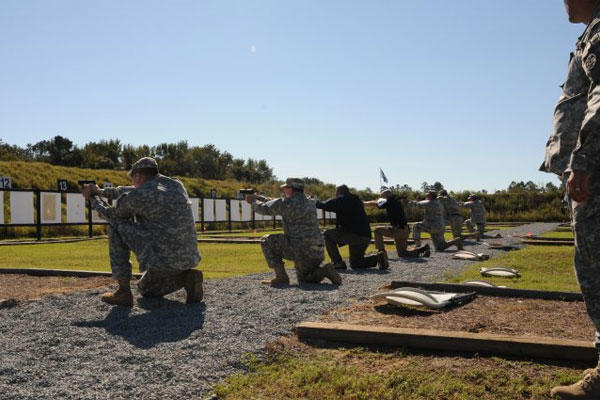MAXTON, N.C. - "Every trigger pull is training."
And that training can be paramount for a special agent, according to Special Agent Jim A. Stillman, with the 6th Military Police Group (Criminal Investigation Division) out of Joint Base Lewis McChord, Wash.
Stillman is one of many instructors leading training during the 200th Military Police Command's 2012 Annual Special Agent Training exercise, held from Sept. 20--30 in Maxton, N.C.
The training exercise, held at the Gryphon Group's Fort Bragg Combat Training Center, brings together U.S. Army Reserve and active duty CID special agents, and other personnel in military and civilian law enforcement together to train on advance and unique training.
Stillman instructed participants on proper stance, loading and reloading of weapons and effective communication skills required during protective services. They're skills the Sterling, Okla., native knows firsthand can help keep agents alive during a very unique job assignment.
He said protective services can be summed up into "months of sheer boredom separated by seconds of sheer terror."
The protective services training included reacting to gunfire and safely transporting a VIP through various scenarios.
During one scenario, a team of special agents responded to simulated gunfire while transporting a VIP in a vehicle. Within seconds, the team had exited the vehicle, firing back at the attackers and safely moving their VIP into cover.
After taking out more attackers, the team made their way from cover to cover--switching between weapon systems and continuously firing at attackers--until finally reaching their getaway vehicle and transporting the VIP to a safe location.
For some teams, the process took less than a minute. Others took longer but that is exactly the point, said Stillman.
"You see your weakness here, and can go back home and work on [improving] it," said Stillman.
Special Agent Tony Perez, with the Army Reserve's 307th Military Police Detachment (CID) out of Jacksonville, Fla., agrees with using more scenario-based training.
"More real-world training and familiarization with all weapons used is extremely important," said Perez, a Cape Canaveral, Fla., native who works with the Port Canaveral Police Department.
Another unique real-world scenario Perez and the other participants were put in was shooting through various openings at stationary and moving targets.
Each participant was provided with training ammunition and stationed in front of three, different colored wooden panels, each with six openings of various sizes numbered one through six.
Each panel had a small staircase in front of it, which participants could use to fire through higher openings but also served as an obstacle for lower openings. On command, they were given a color and a number, and within seconds were required to fire at all three targets. Every two to three seconds, another color and number combination was yelled out by instructors. It wasn't long before the exercise turned into a hectic scramble to keep up.
"That was difficult to remember while firing -- what he's calling out. It showed my weakness and I need to be faster," said Perez. "But my muzzle awareness was good."
"It was great training and it's something the Army CID needs to incorporate [more of]," said Special Agent Rishi R. Rupchand, also with the Army Reserve's 307th MP Det. (CID). This is the second year at ASAT for Rupchand, an Orlando, Fla., native.
"Really important for our agents to do [training]. You never have enough trigger time," said Stillman. "I was satisfied the way everyone was performing."


























